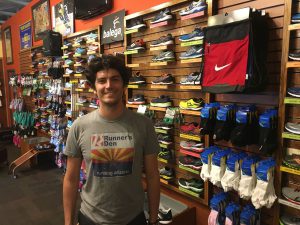Slug: Sports-Running shoes,600
Photo included (thumbnail, caption below)
By RUSS OVIATT
Cronkite News
PHOENIX – Shoes are to runners as tires are to cars. Both run smoothly – or not – with the proper fit.
Brands and styles are almost limitless. Nike is the sales leader globally. According to Statista, Nike topped all others with revenue of $32 billion in 2016.
What footwear company to turn to for the proper fit among all the varying styles, shapes and weights of shoes?
It’s not necessarily Nike.
“Comfort. That’s the magic word,” said Nate Wallack.
Wallack, a second generation employee at Runner’s Den, is an avid runner and uses his personal experience to help runners find the right equipment and shoes. Running has always been a big part of his life.
“I ran track and cross country in high school and college,” said Wallack. “I picked it up a little more with clubs and now I’m doing marathons and half marathons.”
Wallack doesn’t have one brand he loves. Lightweight, flexible and supportive shoes are what he looks for.
As the industry releases new running shoes, all a little different, yet still share some of the same properties.
Running Shoes Guru, who review more than 100 pairs of shoes a year, find the most popular running shoes for weight, cushioning and overall support are from Hoka and Mizuno.
“A big part of what keeps us in business is that everyone is looking for something different, which allows for all these great brands to coexist,’’ said Wallack. “They all carve their own little niche and allows customers to have a lot of variety.”
In past years, the craze of the minimalist shoe reigned. This is a lightweight, flexible shoe with the feeling of almost running barefoot. Lately, the trend has leveled out as runners look for a more cushioned shoe.
“The minimalist shoes are still out there but not as big of a slice of the pie as it was previously,’’ said Wallack.
New materials used in shoes are changing in the industry.
Adidas calls it Boost. “It’s a plastic compound that is air injected, and molded together. It’s made out of these tiny plastic pellets that give the shoe a Styrofoam look,” said Wallack.
The running shoe industry has five key turning points.
Beginning with Nike’s first flats in the late 60’s, shoes evolved into more cushioning by 1971.
Then the shoe industry exploded and stabilized. Early in 2000s, Minimalism introduced a shoe that gave runners the closest feel to the ground.. But the minimalist shoe lost its appeal.
Runners are now looking for shoes that are simply comfortable.
Both avid runners and beginners choose shoes for the same reasons. The difference between them shoes in minimal.
Jeremy McElliott is a trail and marathon runner in Phoenix. He began running in high school and now runs 5k’s, half marathons and triathlons.
“I tend to choose shoes for comfort and functionality,” said McElliott.
Having different shoes for marathon and trail running is crucial. Both must be comfortable and breathable.
In contrast to road running shoes, McElliott wears shoes with a wider toe that allows him to feel the ground more for trails.
McElliott believes society has been so focused on buying narrow shoes that constrain circulation and can cause nerve damage.
“People are getting smarter about the biomechanics of how we run and how are feet sit for natural movement and blood flow,” said McElliott. “I’m seeing more shops actually measure a person’s length and width at all points to make sure a fit is proper.”
Everyone has different preferences, but everyone is chasing comfort.
